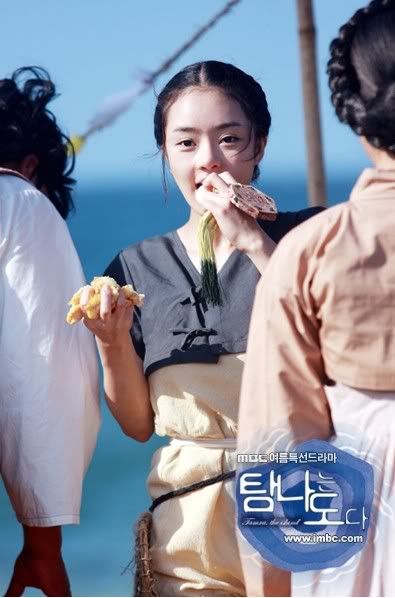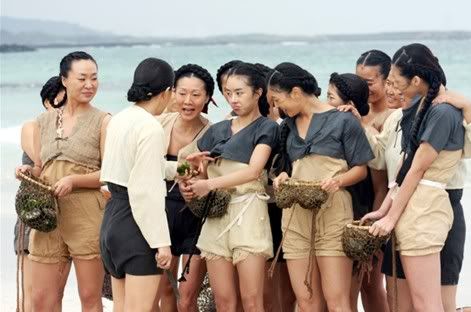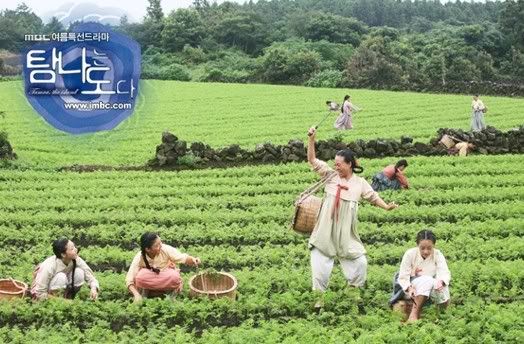You all know I’m a period drama junkie. Sageuks or wuxias, it doesn’t matter. If the men don sexy wigs, wear manly historical garb, and carry a big sword, I’m sold. The ladies need only not annoy me, and we’re square. This particular penchant for historical stuff transcends cultural boundaries. I loves me some Jane Austen BBC and movie adaptations, half-naked beefy men as a Gladiator/Trojan/Persian/Greek, or a bunch of elves guarding a pair of decrepit Towers.
Asian drama period pieces especially heighten the sense of wonder, eclipsing the mundane everyday-ness of our often Westernized lives by adding a dash of exotic fantasy. Some are easier to get into than others. I can sit through the dry-rub history if they throw in the occasional wet-rub eye-sexing, sword fighting, or yo-fool-that’s-my-lady-love-you’re-poaching smackdown. For every nine period drama turkeys, I can usually count of finding that one needle in the haystack.
Tamra the Island (“Tamra”) is the proverbial needle in my great period drama expedition of 2009. It’s also permanently secured a place in my list of top-ten period dramas. In writing this review, I’m actually dismayed that I may have placed it too low on my list. My affection for this drama grows fonder even as I place some distance between us to pick it apart, analyze, and scrutinize it. Tamra made my heart swell and my imagination take flight.
There is no one famous in this drama and it looks kinda dorky – are you sure it’s even good?:
Take a dash of It Started with a Kiss, a pinch of Pride & Prejudice, three shakes from Pocahontas, a splash of The Little Mermaid, then go ahead and mixed all the good parts with an extract of distilled heart, soul, and loving care. The end result is a drama that is unique, refreshing, and utterly beautiful to watch. You won’t mind some recycled tropes, the silliness of the initial poop jokes (not kidding!), or the overall simplicity of the story.
What is striking is not that you’ve seen bits and pieces of all this before, but that you don’t remember when you’ve ever seen this very picture. Say you’ve seen a hundred pastoral watercolors, and when you lay your eyes on your first Monet, suddenly the oft-used pastoral setting looks like nothing you’ve seen before. Tamra takes oft-used elements of effective storytelling, combines them in a charming way, and creates an enjoyable and fresh drama – the coming-of-age fairytale set in period times.
Tamra took over a year to film, including the scenes on Jeju Island (the modern name for Tamra). All filming was completed prior to its airing. If Tamra suffered from anything (which it certainly does), it didn’t suffer from the write, film, and ad-lib-as-you-go last minute production schedule of many K-dramas. The drama looks, feels, and flows with smoothness and finesse.
The drama is based on a manhwa written and illustrated by Jung Hye Na. The author’s bright, sparkling style and comic-book vision has been lovingly adapted to the screen by Group Eight, the production company (which produced such notable dramas as Goong and Boys Before Flowers). Watching Tamra, first you’re struck by the delicate charm of its source material. Then you are hit by the familiar strains of K-drama emotional build-up. Before you know it, you’ve been carried away into an enchanting world, and the drama has coalesced into a delightful blend of the amazing.

Is this the best K-drama ever? No. Is this the best sageuk ever? No. Will this drama bring me tears of joy and smiles of happiness? Yes and yes:
Masterpieces come in all sizes, shapes and colors. I remember reading Victor Hugo’s Les Miserables and being blown away in high school by the sheer scope, breadth and depth of the novel. I foolishly thought: I’ve just read the best novel ever written, nothing can possibly top this. Oh, little koala, speaking in absolutes for one so young, I’m glad you kept your mind open!
Little did I realize at the time that Hugo’s epic was neither the first nor the last great piece of literature or writing. My life has since been enriched by an endless list of short stories, contemporary novels, novellas, essays, etc. Quality may have an objective standard, but a reader’s perception can provide missing pieces. Indeed, great writers and artists create work that inspire their audiences to flights of imagination that transcend the descriptive or illustrative capabilities of mere words, musical notes and pigments.
Tamra is really such an easy-going drama, aiming to tell a story with consideration and sincerity. There is nothing apparently epic about it. When I toss around superlatives to describe Tamra, it’s because the drama touched me like few dramas have done before. Just for the sake of comparison, in Damo, I was moved by how the story was rich in pathos and anguish. In Tamra, I was moved by how the story was rooted in humanism and compassion. I cried both times, but it was tears of sorrow in Damo and tears of joy in Tamra.
The story centers around three young adults who meet each other and go on life journeys, literally and figuratively. By preventing a political conspiracy (the large-scale fantasy element) and figuring out what they want in life (the small-scale personal element), each of them grows into adulthood, learning how to live a meaningful existence. Sounds rather meh, does it? Let me paint Tamra in words for you, and maybe capture but 1/100 of the poetry of this little island.
The drama is so very engaging because it consists of characters we instantly find endearing or relatable. Placed in settings both idyllic and teeming with adventure, we are treated to a visual buffet of gorgeous scenery captured by breathtakingly elegant cinematography. The story extols us to look deep within ourselves, for the parts of us that are loving, generous, and courageous, like the characters we meet. Tamra is beyond life-affirming, it is heart-affirming. You’ll finish Tamra feeling like your heart has grown three sizes.

I don’t want to watch no After School Special, is this fun and interesting?:
Absolutely! Tamra is an peppy cheerful drama that will keep you riveted to the screen, then dying to watch the next episode. (Mr. Koala to poor exhausted sleepy ockoala: “Let’s watch another episode, please, it’s only 2 o’clock in the morning, I want to keep watching!” ockoala throws remote at Mr. Koala’s head). Tamra is set in the Joseon era (16th century Korea), with a narrative propelled by a political conspiracy that keeps the action moving at a steady pace. Oh no, not again, you must be thinking. It’s like every sageuk has to trot out the worn political conspiracy Snuggie to envelop the plot. Well, yes and no.
Let me put it this way, the noble folks in olden-times, they didn’t have time-wasters like a computer, DVD player or PS3. They were bored all the time (the learned arts were also referred to as the boring arts). What else to do? Conspire, of course! Half the conspiracies in dramas are ignited by innocuous gossiping anyways. As repetitive as political intrigues are wont to sound (X wants to overthrow Y), if we repackage it as the rich and fabulous being the Gossip Girls of the Joseon era, now it sounds considerably juicier, right?
Just to be clear though, even by the lowest of sageuk standards, the Tamra political conspiracy is elementary and rather obvious. I half expected the bad guys to have giant neon signs mounted on their hats stating “I am conspiring to do nefarious things”–it didn’t help that the Big Baddie always dressed in black and wore a sinister black wicker helmet. The baddies we encounter are pretty tame all things considering (someone forgot to watch Conspiracy in the Court and Eight Days for some lessons on how to plot like Moriarty).
While the scheming is a critical element of the story, the machinations are kept at a baby-cakes level mostly because this isn’t a gritty dark woe-is-me sageuk. The obviousness of the plotting actually works well with the tenor of this drama, keeping the light fantasy elements in-sync with the heavier plot-driven requirements. But it’s still interesting and fast-paced enough to keep the viewer curious as to how it will all shake out.
“The hallmark of a successful drama is that you feel satisfied when it’s over, but you still want to spend more time with it afterwards.” [Quote from Mr. Koala, the newly-minted K-drama philosopher]:
Tamra is considered a fusion sageuk. In this case, it fused together comic book-esque charm with period gravitas. By taking away the Sturm and Drang that bathes most sageuks, substituting it with playful contemporary considerations, Tamra instantly becomes singularly distinctive. [The first half of Hong Gil Dong had shades of Tamra, but the second half reverted back to the traditional sageuk in plot and tone].

Our lead characters don’t really ponder life, death or destiny, as much as they ponder their future, class, and dreams. Most importantly, we see the ordinary folks simply living life day-by-day. These issues are so easy for me to connect with (and to you, too, I’m presuming). Normally I love the sageuk larger-than-life tableau, and its characters which are grounded in extremes. [The first King of Gorguyeo, the first Queen of Shilla, the first female Joseon physician, the most-famous gisaeng in history, the cleanest slave in the entire universe, and so forth].
Yet when I fell into the pot of dreams that was Tamra, I was astonished to discover you can do a sageuk about normal every day people living in a period setting, and make it a fascinating experience. Tamra introduces characters and tackles issues that are so modern, it was either going to be a giant WTF-this-sucks or a giant OMG-I-love-this. (Uhm, my verdict is the latter, just in case you can’t tell by now).
I can safely recommend Tamra to a younger generation of drama watchers (or even folks like me, who like to think we’re still young) who prefer trendy youthful dramas. The main leads in Tamra feel young, are still young, and their interactions are exuberantly full of life, laughter and tears. The leads in Tamra feel like living, breathing constructs, only they’re living an adventure that is breathtaking in scope and imagination for us. (For those of you who watch or have watched Japanese dramas, Tamra is the closest to a genre I dub “manga-esque fantasy life-affirming giant bowl of love.” These types of J-doramas are not known for its adherence to realism or gritty hard-knocks. Rather, lessons about life, love, perseverance are wrapped in a light, comical, pseudo-wacky shell. But the inner goodness is all as easily relatable and meaningful as it comes.)
I dare say Tamra is a big ole happy ball of win. With that said, you’re free to get off the Tamra love train now. Are you ready to hie yourself off to find the nearest Tamra download of all twenty-one Director’s Cut episodes? Not yet, you want some more concrete proof? Why don’t I tell you the story of Tamra, you can judge for yourself if it seems like your type of entertainment. The following will be so spoilerific, I’m certain you will forgive me for all my previous screw-with-your-head-non-spoilery-reviews.
Read more:


No comments:
Post a Comment